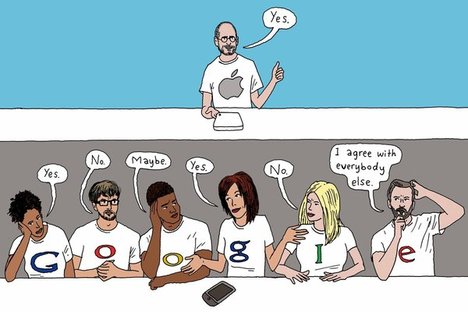 Source of image: online version of the NYT article quoted and cited below.
Source of image: online version of the NYT article quoted and cited below.
(p. 3) Two years ago, the technology blogger John Gruber presented a talk, “The Auteur Theory of Design,” at the Macworld Expo. Mr. Gruber suggested how filmmaking could be a helpful model in guiding creative collaboration in other realms, like software.
The auteur, a film director who both has a distinctive vision for a work and exercises creative control, works with many other creative people. “What the director is doing, nonstop, from the beginning of signing on until the movie is done, is making decisions,” Mr. Gruber said. “And just simply making decisions, one after another, can be a form of art.”
“The quality of any collaborative creative endeavor tends to approach the level of taste of whoever is in charge,” Mr. Gruber pointed out.
Two years after he outlined his theory, it is still a touchstone in design circles for discussing Apple and its rivals.
Garry Tan, designer in residence and a venture partner at Y Combinator, an investor in start-ups, says: “Steve Jobs is not always right–MobileMe would be an example. But we do know that all major design decisions have to pass his muster. That is what an auteur does.”
Mr. Jobs has acquired a reputation as a great designer, Mr. Tan says, not because he personally makes the designs but because “he’s got the eye.” He has also hired classically trained designers like Jonathan Ive. “Design excellence also attracts design talent,” Mr. Tan explains.
For the full story, see:
RANDALL STROSS. “DIGITAL DOMAIN; The Auteur vs. the Committee.” The New York Times, SundayBusiness Section (Sun., July 24, 2011): 3.
(Note: the online version of the story is dated July 23, 2011.)
